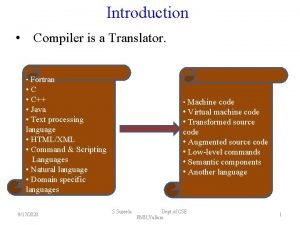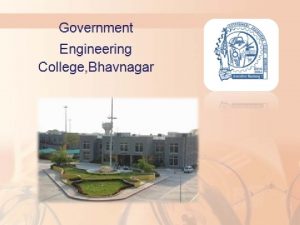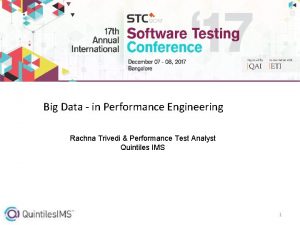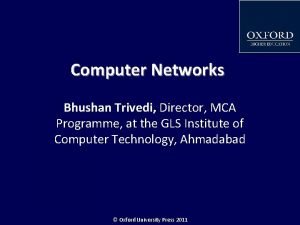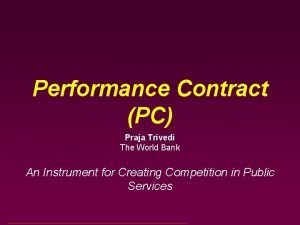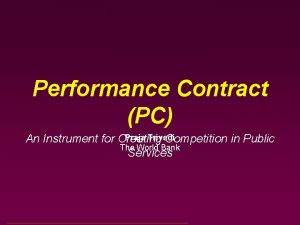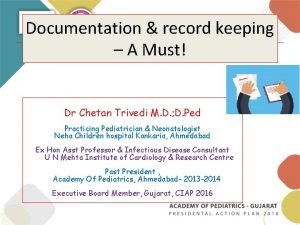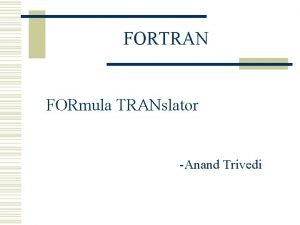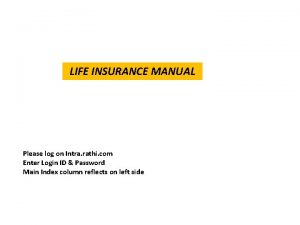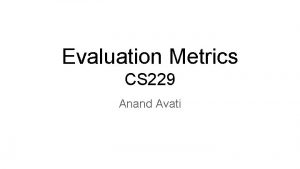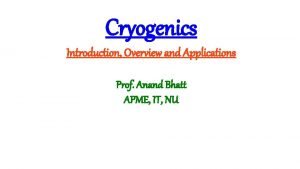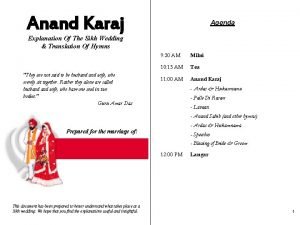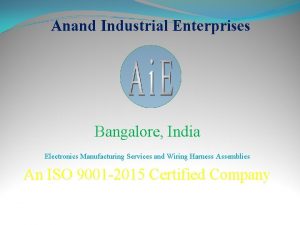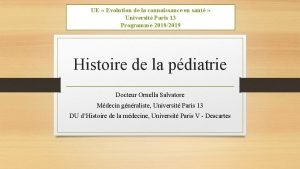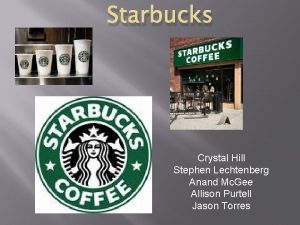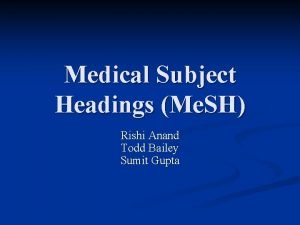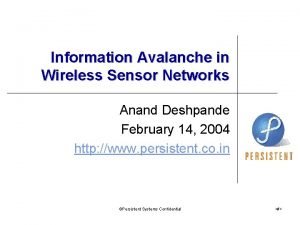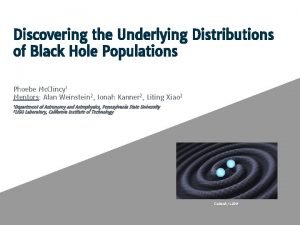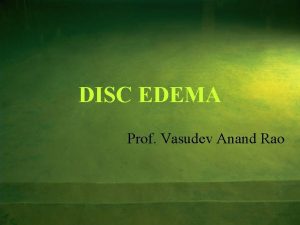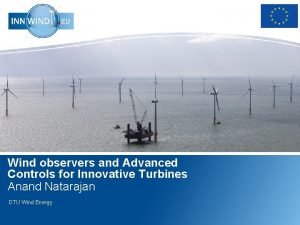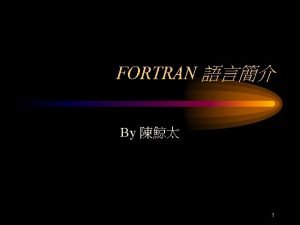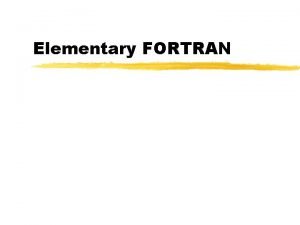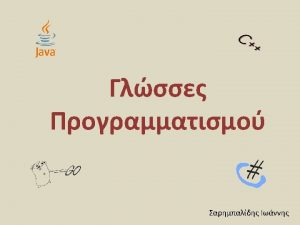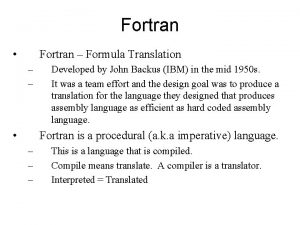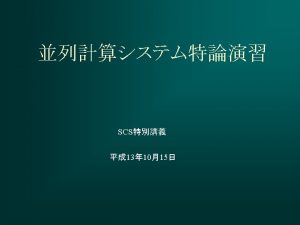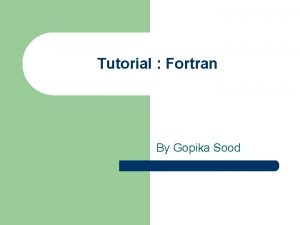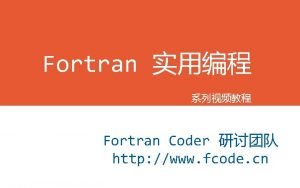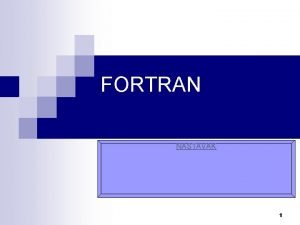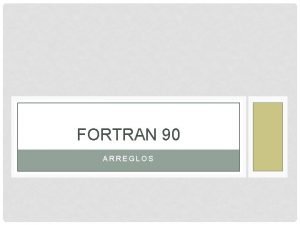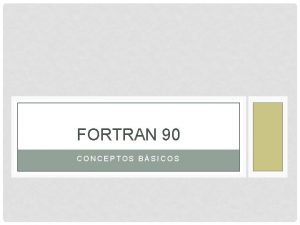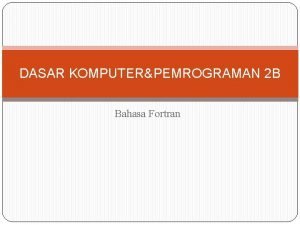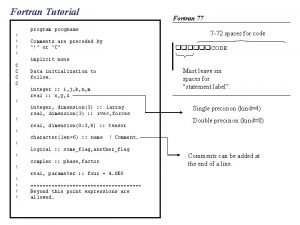FORTRAN FORmula TRANslator Anand Trivedi HISTORY w Designed




















- Slides: 20

FORTRAN FORmula TRANslator -Anand Trivedi

HISTORY w Designed and written from scratch in 195457 by an IBM team lead by John W. Backus as the first ever High Level Language w Direct competition with assembler compelled it to have a fast, well optimized code

INTRODUCTION w Fortran is a general purpose programming language, mainly intended for engineering & scientific computation w Browse over its most popular version Fortran – 77(in 1977)

LEXICAL ASPECTS w Input format : Formerly Punch cards w Not a free format language w Column position rules : n n n Col. 1 : Blank, or a "c" or "*" for comments Col. 2 -5 : Statement label (optional) Col. 6 : Continuation of previous line (optional) Col. 7 -72 : Statements Col. 73 -80: Sequence number (optional, rarely used today) w Delimiters : End of the line w Blank space ignored w Variable names of 1 -6 characters (A-Z, 0 -9). The first character must be a letter.

EXPRESSIONS w Arithmetic Operators : l **, /, *, -, + w Relational Operators : . LT. , . LE. , . GT. , . EQ. , and. NE. w Logical Operators : . NOT. , . AND. , . OR. , . EQV. , . NEQV. w eg: logical a, b a =. TRUE. b = a. AND. 3. LT. 5/2 w Arithmetic expressions are evaluated first, then relational operators, and finally logical operators

DATA TYPES-I w Six data types are explicitly permitted: § § § INTEGER (0, 25, +25, -25) REAL (-1. 5, 3 E 5, +. 123 E-3) DOUBLE PRECISION (1 D 2, 6. 89 D-8) COMPLEX ((-10, 5), (. 4 E 2, -. 31 E-1) LOGICAL(. TRUE. , . FALSE. ) CHARACTER(‘Don’’t’, ’A 1 PLC+/’)

DATA TYPES-II w Each variable has to be declared explicitly w Implicit rule : All variables starting with the letters i-n are integers and all others are real w CONSTANT : By using PARAMETER statement w eg. parameter (pi = 3. 14159)

SAMPLE EXAMPLE- I w 12345678901234567890 program circle real r, area pi parameter (pi = 3. 14159) C write & read statements for I/p O/p write (*, *) 'Give radius r: ' read (*, *) r area = pi*r*r write (*, *) 'Area = ', area stop end

DATA TYPES-III w Supports multiple assignments : n eg: data m, n/10, 20/, x, y/2*2. 5/ or n data m/10/, n/20/, x/2. 5/, y/2. 5/

DATA TYPES : ARRAYS w The only complex data structure w Index starts from 1 onwards : INTEGER i(10) , REAL a(12), REAL b(*) w However these are also valid : REAL b(0: 19), REA: weird(-162: 237) w Allows arrays of up to seven dimensions REAL a(3, 5), REAL b(2, 0: 3) w By default values are not Zero. w Array values are not checked before being used.

CONTROL STATEMENTS-I w w GOTO statement : GOTO label IF statement : Arithmetic if : IF (e)s 1, s 2, s 3 n l Logical if : IF(e)statement n l w Eg. IF((A+B)*2)100, 200, 300 Eg. IF(A. LT. 0. )a=0. 0 IF-THEN-ELSE Statement : If (e) THEN [statements] Else [statements] END IF w Nested IF allowed

CONTROL STATEMENTS-II w CONTINUE w Just one type of loop : DO loop w eg integer i, n, sum n = 10 DO 10 i = 0, n, 2 write(*, *) 'i =', i 10 CONTINUE w No recursion (static allocation)

FUNCTIONS w Inbuilt functions like : abs, sin, cos etc w Define own functions : real function r(m, t) real t, m r = 0. 1*t * (m**2 + 14*m) if (r. LT. 0) r = 0. 0 return end

SUBROUTINES w Makes language modular w No global variables. So subroutines helps to pass it. Eg : c subroutine iswap (a, b) integer a, b Local variables integer tmp = a a=b b = tmp return end

CALL BY REFERENCE PARADIGM Fortran follows call by reference paradigm. Eg. program callex integer m, n m=1 n=2 call iswap(m, n) write(*, *) m, n stop end c subroutine iswap (a, b) integer a, b Local variables integer tmp = a a=b b = tmp return end

FORMAT STATEMENT w Used for particular input or output format w The most common format code letters are: § § § § A - text string D - double precision numbers, exponent notation E - real numbers, exponent notation F - real numbers, fixed point format I - integer X - horizontal skip (space) / - vertical skip (newline)

THINGS NOT COVERED w Input and Output concepts w Input and Output statements l (READ, WRITE, PRINT, OPEN, CLOSE, INQUIRE. . ) w Format specifications l (Numeric editing, Logical editing, Character editing. . )

PRESENT APPLICATIONS w Cosmology, fusion research, surface physics, molecular dynamics…. w Nasa’s Anisotropy probe (flown in 2000) used some legacy f-77 though mostly f-90 w US geological survey still uses f-77!. . .

PRESENT & FUTURE w F-90 has free format, dynamic allocation and pointers, user defined data type, modules, recursive functions, built-in arrays & operator overloading. w Fortran 2000 (delayed to 2004) hopes to have object orientation, interoperability with C, asynchronous I/o and lot more

REFERENCES w w w http: //personal. cfw. com/~terry 2/tutorial http: //www. ibiblio. org/pub/languages/fortran/unfp. html http: //physics. weber. edu/ostlie/phsx 2300/future. pdf http: //macams 1. bo. infn. it/tutorial/format. html http: //sunsite. univalle. edu. co/fortran/ch 2 -3. html w Fortran-77 - Harry Katzan w Structured Fortran 77 Programming - Seymour Pollack
 Compiler
Compiler Chetan trivedi
Chetan trivedi Rachna trivedi
Rachna trivedi Dr bhushan trivedi
Dr bhushan trivedi Praja trivedi
Praja trivedi Praja trivedi
Praja trivedi Dr chetan trivedi pediatrician
Dr chetan trivedi pediatrician Formula translator
Formula translator Intra anand rathi
Intra anand rathi Anand avati
Anand avati Anand bhatt md
Anand bhatt md Sikh wedding shabads
Sikh wedding shabads Silicon valley of india
Silicon valley of india Kanwaljeet anand
Kanwaljeet anand Starbucks anand
Starbucks anand Rummy glle
Rummy glle Dr rishi anand
Dr rishi anand Anand deshpande house
Anand deshpande house Shreya anand caltech
Shreya anand caltech Tereth anand rao
Tereth anand rao Anand natarajan dtu
Anand natarajan dtu
